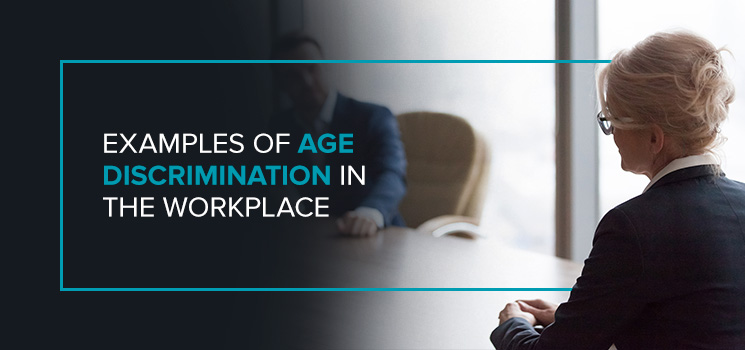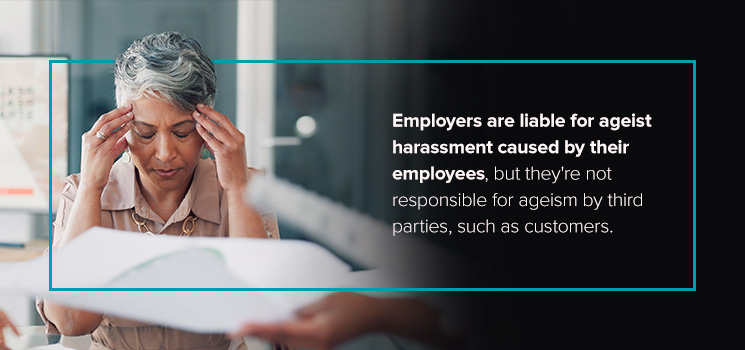By Weisberg Cummings, P.C. on October 26th, 2023
Age discrimination or ageism in the workplace refers to the unfair treatment, prejudice or stereotypical behavior against employees because of their age. It affects young and older workers and may be perpetuated by employers, managers and co-workers. Ageism can occur at any stage of your career, from the recruiting process, through training and advancement, to retirement or termination.
Elderly discrimination in the workplace is illegal according to the Age Discrimination in Employment Act (ADEA) created in 1967. The act protects workers over 40 years old, sometimes called older employees, from harassment and discrimination in the workplace. It applies to employment, federal, local and state agencies; companies with at least 20 employees; and labor organizations with at least 25 members.
Unfortunately, the ADEA doesn’t protect people younger than 40, military personnel or independent contractors from ageism. The Pennsylvania Human Relations Act (PHRA) also protects workers in companies with four or more employees against workplace harassment and discrimination based on age.
Despite the efforts by the local and federal governments, age discrimination claims are still on the rise. This article covers age discrimination in the workplace examples that could necessitate filing a claim against your employer.
1. Direct Age Discrimination
Direct age discrimination manifests when employees are denied opportunities such as employment, promotions and training due to their age. This type typically affects older employees, who are passed over in favor of younger employees. Often, employers or managers deny older people employment and promotions because they believe they can’t perform as well as younger employees.
Employers may deny them training and advancement opportunities to make them look bad and eventually push them toward retiring or quitting. They may also exempt people of a certain age from job advertisements, specifying age limits for applicants or using suggestive language such as “15 years experience” or “recent graduates” to deter people from specific age groups from applying.
The ADEA prohibits employers from advertising age preferences and asking about the age of potential employees during the interview process. For example, the Equal Employment Opportunity Commission (EEOC) sued Lilly USA, a pharmaceutical corporation in Indiana, for intentionally refusing to hire older workers for sales representative positions between 2017 and 2021.
However, employers are also protected by the bona fide occupational qualification (BFOQ) clause when a job can only be performed by people of a certain age.
Direct age discrimination may also take the guise of mass layoffs, with most victims over 40. Employers may attempt to neutralize discrimination by including a few younger employees. Still, if most of those laid off are older employees, it’s good to assess patterns and examine the underlying reasons for the terminations.
2. Indirect Age Discrimination
Indirect discrimination based on age refers to the intentional or unintentional implementation of policies that apply to all members of an organization but affect older employees more than others. These policies and practices subtly push older employees out of the organization, often before they’re due for retirement.
Some top examples of indirect ageism in the workplace include:
- Eliminating an older employee’s job role or declaring them redundant and creating a new position that fulfills the same requirements but with a new title. Employers do this to hire new talent to perform the same job at a lower cost.
- Creating a hostile environment and putting older employees with strong histories on random performance improvement plans. This behavior is often an attempt to find a legal way to fire someone.
- Introducing mandatory retirement age to pressure older employees to take early retirement despite them still being able to work at full capacity.
- Encouraging older employees to retire by offering hard-to-resist early retirement packages. These offers put employees in a difficult position because employers may fire them or retaliate if they don’t accept the packages.
3. Harassment Based on Age
Age harassment in the workplace is demonstrated through aggressive or offensive behavior toward employees because of their age. It may be intentional or unintentional, but it intimidates people and violates their dignity. Age harassment also creates a hostile environment that makes it difficult for the victim to perform optimally and may lead to demotion, loss of wages, quitting or firing.
Employers are liable for ageist harassment caused by their employees. Here are some age harassment examples you may encounter in the workplace:
- Managers or supervisors may harass older staff by reprimanding them for mistakes that other employees typically get away with.
- Co-workers make jokes and mean comments about someone being too old to perform their work.
- Older employees are left out of meetings, events and brainstorming sessions because they “can’t keep up.”
- Co-workers or managers belittle or dismiss an employee’s ideas because they are perceived as “too old” to make meaningful contributions.
- Colleagues or supervisors make demeaning remarks about a worker’s older partner, friend or family member.
4. Victimization Because of Age
Victimization happens when a specific employee is held to a higher standard or treated harshly because they complained or reported an instance of age discrimination in the workplace. Employees may also experience age-based victimization when they assist with or witness another employee’s age discrimination complaint.
Victimization due to age discrimination or harassment reports may take any of the following forms:
- Demotion
- Reduced hours
- Forced retirement
- Undue reprimands
- Wrongful termination
- Reduced or denied wages and benefits
Employees may also be victimized when their desks are moved and isolated from the rest of their departments after supporting or launching age discrimination claims. In some cases, they start receiving fewer tasks or projects below their skill level to demotivate and humiliate them. With today’s dynamic working environment, older employees may also be victimized by being forced to work from home, either full-time or part-time.
Weisberg Cummings Can Help You Handle a Possible Age Discrimination Claim
It may be difficult to prove or handle an age discrimination claim alone. Weisberg Cummings age discrimination lawyers can help you navigate the entire process with ease and confidence. Our experienced lawyers will manage all the details, file the necessary documents, present your claim, and negotiate the settlement and compensation you’re entitled to.
You can trust us to offer you the support you need throughout the case and give you the time and attention you deserve. If you’d like us to review your possible age discrimination case at the workplace, request a free consultation today, and we’ll be in touch to review your options.



